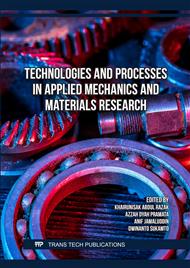p.3
p.11
p.19
p.27
p.35
p.41
p.49
p.59
Rheology Investigation of Metal Injection Molding Feedstock Based on Powder Particle Shape and Solid Loading
Abstract:
Metal injection molding (MIM) feedstock is composed of Cu powder and a complex binder system that consists of PA6, MgSt, and GMS with various solid loading (43-53vol%). Cu powders used are fabricated by gas and water atomization. Powder particle shapes used have spherical and dendritic shapes. Sphericity of particles can be identified by Scanning Electron Microscopy (SEM). A rheology test is used to ensure the optimum solid loading and investigate the influence of particle shape. The pseudo-plastic behavior of all the feedstock is exhibited by decreasing viscosity along with increasing shear rate for all working temperatures. In this study, rheological test result such as viscosity, flow activation energy, and flow behavior index of feedstock indicates that the optimum solid loading was selected as 43 vol%. Both gas and water atomized powders are desirable for MIM feedstock. According to the rheology behavior test, gas-atomized powders with spherical shape has better rheology stability than water-atomized powders with dendritic shape. The proper MIM feedstock was selected to solid loading 43 vol% with gas-atomized powders.
Info:
Periodical:
Pages:
27-33
Citation:
Online since:
January 2024
Keywords:
Price:
Сopyright:
© 2024 Trans Tech Publications Ltd. All Rights Reserved
Share:
Citation:



